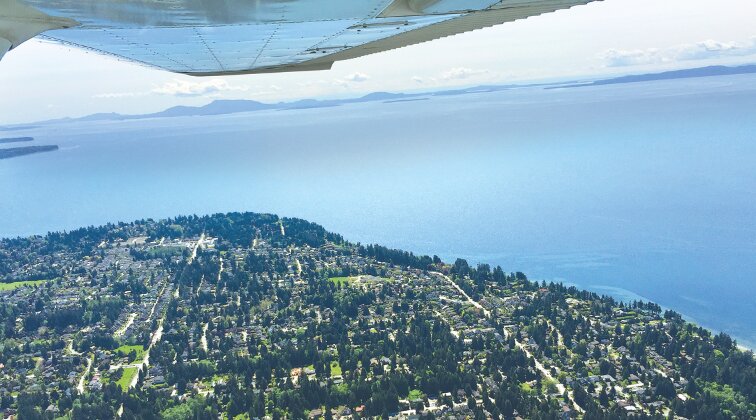
By Patrick Grubb
The aeroplane has unveiled for us the true face of the earth – Antoine de Saint-Exupery
Have you ever looked up at a small airplane in the sky and thought, “I’d like to be able to fly?” If so, you’ll be pleased to know that learning to fly is eminently doable. In recent years, both the U.S. and Canadian governments have introduced pilot’s certificates that involve less training and expense than the standard private pilot’s licenses. In the States, would-be pilots can train for a sport pilot or a recreational pilot license. In Canada, it’s called the recreational pilot permit.
Regardless of where you learn to fly, this class of certificate is more restrictive than private pilot licenses. For example, a recreational pilot in Canada can only fly during daytime in planes with four or fewer seats, carry just one passenger and are restricted to a certain distance from their home airport. The rules are similar in the U.S. except the sport pilot certificate applies to light sport aircraft (LSA). LSAs can only have two seats, a maximum speed of 138 mph, fixed landing gear and so on. LSA capabilities are higher than what the U.S. allows for ultralights in terms of speed, weight and fuel capacity.
Flying might not be all plain sailing, but the fun of it is worth the price – Amelia Earhart
For many people, the choice between getting a private pilot’s license (PPL) and this kind of certificate (RPC) is a matter of time, money and reason for flying. If you’re considering flying as a career or don’t want to be subject to RPC restrictions, there’s no choice – you need to get your PPL. For others, the RPC may be all they need or desire.
No matter which certificate you pursue, both require a significant expenditure of time and money. In Canada, a RPC requires a minimum of 15 hours of dual instruction and 10 hours of solo flying versus 40 hours of dual and 15 of solo for the PPL. Most people require more than the minimum flying hours to master the skills needed to fly safely.
There’s more, of course. There’s ground instruction, books and supplies, headsets, exam and license fees and so on. Again, in Canada, you can expect to pay $6,000 and up for a RPC and $12,000 and up for a PPL. In the States, the costs are lower; expect to pay $7,000 to $10,000 for a PPL; a RPC should be around $6,000 or so.
The knack of flying is learning how to throw yourself at the ground and miss – Douglas Adams
If you think you’re interested in learning to fly, the first thing to do is to schedule an introductory flight at a local flight school (more about these later). A half hour flight in which you’ll take the controls for part of the time usually runs around $120 and will give you a good idea of whether you’re cut out to fly a small plane. At the very least, you’ll get a good aerial view of your hometown. But, if you’re feeling green around the gills, you’ll probably want to try a different adventure that stays on the ground.
There is no shortage of flight schools in the Lower Mainland and northwest Washington. Factors you should consider in choosing a school include the size of the fleet, number of instructors, where it’s located, how long it’s been in existence and whether the school is accredited.
All things being equal, location could be the deciding factor. Daniella Hlynka, a flight instructor with the Pacific Flying Club at Boundary Bay Airport in Delta, B.C., says the ideal training schedule is two or three times a week. A high frequency of lessons means you spend each flight building on what you’ve already learned and not in reviewing past lessons. And, inevitably, there will be days when the weather grounds training flights. Both the U.S. and Canada require that students receive a medical exam by an authorized doctor before they solo – it’s best to get it out of the way at the beginning.
The focus and the concentration and the attention to detail that flying takes is a kind of meditation. I find it restful and engaging, and other things slip away – Harrison Ford
Asked to describe the type of student she encounters, Hlynka said she has students who are interested in flying as a career but currently the bulk of her students are adults who are retired or close to retiring and looking for a new activity to keep them occupied. Mark Young, a flight instructor at Command Aviation at Bellingham International Airport (BIA), reported the same phenomenon. “I see people who might have taken lessons years ago and then family life intervened. Now that the kids have grown and flown the coop, they decide they want to finish what they started. Others now have the time and the money and decide they want to learn to fly,” he said. “I can’t think of anything better than flying to keep people’s mental juices flying – it’s a really good way to keep yourself sharp. How much of a hoot is it to hop into a plane at BIA and fly 30 minutes to Friday Harbor, have lunch and fly home? It would take you all day by ferry.”
How long it takes to get your PPL is really dependent on your schedule, your budget and what time of the year you start. Young recently had a young pilot who flew two to three times a week and took four months to become licensed. “Learning to fly is probably the biggest and most enjoyable challenge a person can undertake. I get a thrill each time one of my students solos for the first time – that big smile stretching across their face gets me every time.” x
Pacific Flying Club
4335 Skeena Street
Delta, B.C., V4K 0A6
604/946-0011